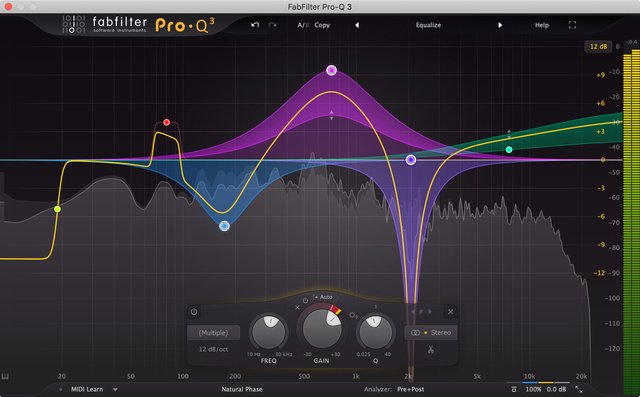Audio Production Pro-Tips: Using EQ

Pro-Tips for Working with an EQ:
- Let me start by STRESSING that Equalization should be done at the RECORDING STAGE first and foremost. Herewith lays the grand mistake of the amateur producer. If you record it wrong, there is not amount of Equalization in the world that is going to make it sound professional, as you can only add or cut the information that is already in the raw audio file. The goal, in order to achieve a good final production is to use the LEAST amount of Equalization at the production stage. So record it right regardless of the time you will spend moving microphones and instruments around the room and fiddling with knobs, because that will save you a lot of time (and quality) in the following stages.
- Always level match after equalizing. What does this mean? When equalizing you will be changing the volume of the outgoing audio, it will be louder if you do boosts and quieter if you do cuts, therefore you will be comparing audio at different volumes and what's the silver rule? That's right, louder will always sound better even if it ain't better. Therefore always level match to assess correctly the changes you just did.
- Adding to what I wrote above, sometimes it's also good to push it really loud to see the effect of the EQ curve on those highs and lows, so that that Fletcher-Munson curve has got nothing on you at the mastering stage. Obviously, careful with the equipment, careful with your ears, just loud enough to check if there's too much hissing (highs) or too much thumping (lows).
Mono check. Mono check. Mono check. I hope I said it enough times. Always check you mix in mono every now and then and, especially, after equalizing stuff with wide stereo effects. More often than not, much of what you hear will be gone in mono. You DO NOT want to be playing your track in someone's car speakers and realize that it sounds nothing like what it did in the studio. Or worse yet, got it playing on the radio and suddenly those synths are gone. Where are the synths? Gone! Because you didn't check the mix in mono. It will happen, believe me.
Different Equalizers will have different effects on the raw audio. While you make a high pass in some equalizers and this will silence the low end completely, in other it won't and low end information will still be processed even if you won't hear it (especially when monitoring with low end equipment), so use a spectrum analyzer after the EQ, to check how that particular EQ is dealing with the incoming audio. This will also save you headroom in the mastering stage.
- Not exactly a rule, more of a guideline, use broad Q's for boosts and narrow Q's for cuts. It tends to keep the quality of the sound more professional. It's also good policy to try and reverse-compensate: if you boost, cut somewhere else and vice-versa, I found that this keeps the sound closer to the source than just cutting or boosting.
- Avoid equalizing a track in solo mode. By equalizing in solo you are not adjusting the track to the sonic context and issues will rise when you play it back together with the whole mix, mainly frequency masking and/or phasing issues. If you are hellbent into dong some fine tuning, set that track louder than the rest of the mix and fine tune it then, that way you'll not lose perspective.
- With EQ (and mostly everything in audio production compressors, reverbs, exciters, etc.) usually LESS IS MORE!. Sure you can get creative with stuff, but remember that after a couple of hours in the studio you will now (unknowingly!) be dealing with ear fatigue and you will tend to exacerbate the functions of certain tools, because you ears have already self-calibrated to that track. Then you'll hear it the next day and it will sound really amateurish (especially in mono, probably), because you overdid everything. Instead of 2 sec reverb go for 0.8 or 1.2 second. Instead of cutting that frequency by 4db try 2db. And tomorrow, if you can still hear a problem then go nuts!
- Don't depend too much on visualization. Trust your hears. Sure, visualization is good to nail down some problematic frequencies with a spectrometer, but it can become an hindrance if you get too used to it. Your ears are the only truth.
- And finally, forget EVERYTHING I just wrote and remember the Golden Rule: if it sounds good, it is good!
Hope this was useful! Feel free to leave any comments below.
(Edited from an original Narrative.org article: https://www.narrative.org/post/audio-production-pro-tips-using-eq)
Initial Image Attribution: Fab Filter Pro-Q 3
Warning! This user is on our black list, likely as a known plagiarist, spammer or ID thief. Please be cautious with this post!
If you believe this is an error, please chat with us in the #appeals channel in our discord.
ongoing appeal!
This post had received 20.79% upvote from @steemitportugal account!
Our website has lots of news and tutorials you can visit right now at www.steemitportugal.com
Click here to vote

Delegation for daily voting: 10SP-25SP-50SP-100SP-250SP-500SP-1000SP
hmmm, ongoing appeal to the claim of steemcleaner... what about source recognition to this article written in July this year at narrative.org? A full copy/paste without any alteration; Not even the title. https://www.narrative.org/post/audio-production-pro-tips-using-eq
@qsounds yes, that was also us, as you can see by the name of the author. and it's not the same article as we have edited out the introduction from the original article since it wouldn't make much sense here.
Yes, that was also
Us, as you can see by the
Name of the author.
- whymonkey
I'm a bot. I detect haiku.
@qsounds, just for reference, mate, I've just been unbanned by steemcleaners you can check it here: https://steemit.com/poetry/@whymonkey/broken-old-car-amateur-poetry
plagiarism?! not us brother